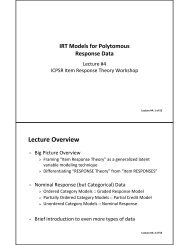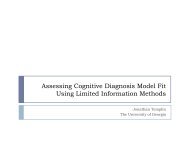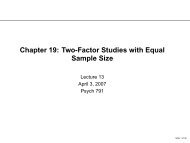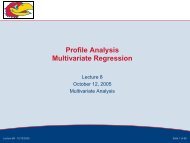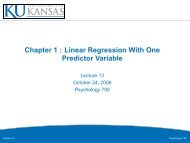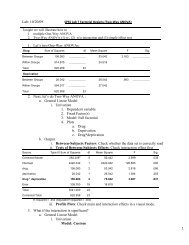Chapter 5: Matrix Approaches to Simple Linear Regression
Chapter 5: Matrix Approaches to Simple Linear Regression
Chapter 5: Matrix Approaches to Simple Linear Regression
Create successful ePaper yourself
Turn your PDF publications into a flip-book with our unique Google optimized e-Paper software.
Our New ScheduleDate Topic <strong>Chapter</strong>11/9 <strong>Matrix</strong> algebra K 511/14 Multiple regression I K 611/16 Multiple regression II K 711/21 No Class11/23 No Class - No Lab11/28 <strong>Regression</strong> models for quantitative and qualitative predic<strong>to</strong>rs K 811/30 Building the regression model I K 912/5 Building the regression model II K 1012/7 Building the regression model III (Final Handed Out) K 11Lecture 17 Psychology 790
<strong>Matrix</strong> AlgebraLecture 17 Psychology 790
<strong>Matrix</strong> IntroductionOverview<strong>Matrix</strong> Algebra➤ Introduction➤ Definitions➤ Matrices➤ <strong>Matrix</strong> Computing➤ MatricesAlgebraMore MatricesGeneral <strong>Linear</strong>ModelOther <strong>Matrix</strong>Products● Imagine you are interested in studying the culturaldifferences in student achievement in high school.● Your study gets IRB approval and you work hard <strong>to</strong> getparental approval.● You go in<strong>to</strong> school and collect data using many differentinstruments.● You then input the data in<strong>to</strong> your favorite stat package (or MSExcel).● How do you think the data is s<strong>to</strong>red?Wrapping UpLecture 17 Psychology 790
Definitions● We begin this class with some general definitions (from dictionary.com):✦ <strong>Matrix</strong>:1. A rectangular array of numeric or algebraic quantities subject <strong>to</strong>mathematical operations.2. The substrate on or within which a fungus grows.✦ Algebra:1. A branch of mathematics in which symbols, usually letters of thealphabet, represent numbers or members of a specified set and areused <strong>to</strong> represent quantities and <strong>to</strong> express general relationships thathold for all members of the set.2. A set <strong>to</strong>gether with a pair of binary operations defined on the set.Usually, the set and the operations include an identity element, and theoperations are commutative or associative.Lecture 17 Psychology 790
MatricesOverview<strong>Matrix</strong> Algebra➤ Introduction➤ Definitions➤ Matrices➤ <strong>Matrix</strong> Computing➤ MatricesAlgebraMore MatricesGeneral <strong>Linear</strong>ModelOther <strong>Matrix</strong>Products● Away from the definition, a matrix is simply a rectangular wayof s<strong>to</strong>ring data.● Matrices can have unlimited dimensions, however for ourpurposes, all matrices will be in two dimensions:✦ Rows✦ Columns● Matrices are symbolized by boldface font in text.[ ]4 7 5A =6 6 3Wrapping UpLecture 17 Psychology 790
MATLABOverview<strong>Matrix</strong> Algebra➤ Introduction➤ Definitions➤ Matrices➤ <strong>Matrix</strong> Computing➤ MatricesAlgebraMore MatricesGeneral <strong>Linear</strong>ModelOther <strong>Matrix</strong>ProductsWrapping Up● To help demonstrate the <strong>to</strong>pics we will discuss <strong>to</strong>day, I will beshowing examples in MATLAB.● MATLAB (<strong>Matrix</strong> Labora<strong>to</strong>ry) is a scientific computingpackage typically used in other technical fields.● For many statistical applications MATLAB is very useful.● MATLAB is available in Psychology and throughout thecampus.● SPSS and SAS both have matrix computing capabilities, but(in my opinion) neither are as efficient, as user friendly, or asflexible as MATLAB.✦ It is better <strong>to</strong> leave most of the statistical computing <strong>to</strong> thecomputer scientists.Lecture 17 Psychology 790
<strong>Matrix</strong> ElementsOverview<strong>Matrix</strong> Algebra➤ Introduction➤ Definitions➤ Matrices➤ <strong>Matrix</strong> Computing➤ MatricesAlgebraMore MatricesGeneral <strong>Linear</strong>ModelOther <strong>Matrix</strong>ProductsWrapping Up● A matrix is composed of a set of elements, each denoted it’srow and column position within the matrix.● For a matrix A of size r × c, each element is denoted by:a ij✦ The first subscript is the index for the rows: i = 1, . . .,r.✦ The second subscript is the index for the columns:j = 1, . . .,c.⎡⎤a 11 a 12 . . . a 1ca 21 a 22 . . . a 1cA =⎢⎣...⎥. ⎦a r1 a r2 . . . a rcLecture 17 Psychology 790
TransposeOverview<strong>Matrix</strong> Algebra➤ Introduction➤ Definitions➤ Matrices➤ <strong>Matrix</strong> Computing➤ MatricesAlgebraMore MatricesGeneral <strong>Linear</strong>Model● The transpose of a matrix is simply the switching of theindices for rows and columns.● An element a ij in the original matrix (in the i th row and j thcolumn) would be a ji in the transposed matrix (in the j th rowand the i th column).● If the original matrix was of size i × j the transposed matrixwould be of size j × i.[ ]4 7 5A =6 6 3Other <strong>Matrix</strong>ProductsWrapping UpA ′ =⎡⎢⎣4 67 65 3⎤⎥⎦Lecture 17 Psychology 790
Types of MatricesOverview<strong>Matrix</strong> Algebra➤ Introduction➤ Definitions➤ Matrices➤ <strong>Matrix</strong> Computing➤ MatricesAlgebraMore MatricesGeneral <strong>Linear</strong>ModelOther <strong>Matrix</strong>ProductsWrapping Up● Square <strong>Matrix</strong>: A matrix that as the same number of rowsand columns.✦ Correlation and covariance matrices are examples ofsquare matrices.● Diagonal <strong>Matrix</strong>: A diagonal matrix is a square matrix withnon-zero elements down the diagonal and zero values for theoff-diagonal elements.A =⎡⎢⎣2.759 0 00 1.643 00 0 0.879● Symmetric <strong>Matrix</strong>: A symmetric matrix is a square matrixwhere a ij = a ji for all elements in i and j.✦ Correlation/covariance and distance matrices areexamples of symmetric matrices.⎤⎥⎦Lecture 17 Psychology 790
Vec<strong>to</strong>rsOverview<strong>Matrix</strong> Algebra➤ Introduction➤ Definitions➤ Matrices➤ <strong>Matrix</strong> Computing➤ MatricesAlgebraMore MatricesGeneral <strong>Linear</strong>ModelOther <strong>Matrix</strong>ProductsWrapping Up● A vec<strong>to</strong>r is a matrix where one dimension is equal <strong>to</strong> sizeone.✦ Column vec<strong>to</strong>r: A column vec<strong>to</strong>r is a matrix of size r × 1.✦ Row vec<strong>to</strong>r: A row vec<strong>to</strong>r is a matrix of size 1 × c.● Vec<strong>to</strong>rs allow for geometric representations of matrices.● The Pearson correlation coefficient is a function of the anglebetween vec<strong>to</strong>rs.● Much of the statistical theory given in this course (andANOVA-type courses) can be conceptualized by projectionsof vec<strong>to</strong>rs (think of the dependent variable Y as a columnvec<strong>to</strong>r).Lecture 17 Psychology 790
Scalars● A scalar is a matrix of size 1 × 1.Overview<strong>Matrix</strong> Algebra➤ Introduction➤ Definitions➤ Matrices➤ <strong>Matrix</strong> Computing➤ MatricesAlgebra● Scalars can be thought of as any single value.● The difficult concept <strong>to</strong> get used <strong>to</strong> is seeing a number as amatrix:[ ]A = 2.759More MatricesGeneral <strong>Linear</strong>ModelOther <strong>Matrix</strong>ProductsWrapping UpLecture 17 Psychology 790
AlgebraLecture 17 Psychology 790
Algebraic OperationsOverview<strong>Matrix</strong> AlgebraAlgebra➤ Algebra➤ Addition➤ Subtraction➤ Multiplication➤ Identity➤ Zero➤ Unity <strong>Matrix</strong>➤ “Division”➤ Singular MatricesMore MatricesGeneral <strong>Linear</strong>Model● As mentioned in the definition at the beginning of class,algebra is simply a set of math that defines basic operations.✦ Identity✦ Zero✦ Addition✦ Subtraction✦ Multiplication✦ Division● <strong>Matrix</strong> algebra is simply the use of these operations withmatrices.Other <strong>Matrix</strong>ProductsWrapping UpLecture 17 Psychology 790
<strong>Matrix</strong> AdditionOverview<strong>Matrix</strong> AlgebraAlgebra➤ Algebra➤ Addition➤ Subtraction➤ Multiplication➤ Identity➤ Zero➤ Unity <strong>Matrix</strong>➤ “Division”➤ Singular Matrices● <strong>Matrix</strong> addition is very much like scalar addition, the onlyconstraint is that the two matrices must be of the same size(same number of rows and columns).● The resulting matrix contains elements that are simply theresult of adding two scalars.More MatricesGeneral <strong>Linear</strong>ModelOther <strong>Matrix</strong>ProductsWrapping UpLecture 17 Psychology 790
<strong>Matrix</strong> AdditionOverview<strong>Matrix</strong> AlgebraAlgebra➤ Algebra➤ Addition➤ Subtraction➤ Multiplication➤ Identity➤ Zero➤ Unity <strong>Matrix</strong>➤ “Division”➤ Singular Matrices⎡A = ⎢⎣⎡B = ⎢⎣⎤a 11 a 12a 21 a 22⎥a 31 a 32 ⎦a 42a 41⎤b 11 b 12b 21 b 22⎥b 31 b 32 ⎦b 42b 41More MatricesGeneral <strong>Linear</strong>ModelOther <strong>Matrix</strong>ProductsWrapping UpA + B =⎡⎢⎣⎤a 11 + b 11 a 12 + b 12a 21 + b 21 a 22 + b 22⎥a 31 + b 31 a 32 + b 32 ⎦a 41 + b 41 a 42 + b 42Lecture 17 Psychology 790
<strong>Matrix</strong> SubtractionOverview<strong>Matrix</strong> AlgebraAlgebra➤ Algebra➤ Addition➤ Subtraction➤ Multiplication➤ Identity➤ Zero➤ Unity <strong>Matrix</strong>➤ “Division”➤ Singular Matrices● <strong>Matrix</strong> subtraction is identical <strong>to</strong> matrix addition, with theexception that all elements of the new matrix are thesubtracted elements of the previous matrices.● Again, the only constraint is that the two matrices must be ofthe same size (same number of rows and columns).● The resulting matrix contains elements that are simply theresult of subtracting two scalars.More MatricesGeneral <strong>Linear</strong>ModelOther <strong>Matrix</strong>ProductsWrapping UpLecture 17 Psychology 790
<strong>Matrix</strong> SubtractionOverview<strong>Matrix</strong> AlgebraAlgebra➤ Algebra➤ Addition➤ Subtraction➤ Multiplication➤ Identity➤ Zero➤ Unity <strong>Matrix</strong>➤ “Division”➤ Singular Matrices⎡A = ⎢⎣⎡B = ⎢⎣⎤a 11 a 12a 21 a 22⎥a 31 a 32 ⎦a 42a 41⎤b 11 b 12b 21 b 22⎥b 31 b 32 ⎦b 42b 41More MatricesGeneral <strong>Linear</strong>ModelOther <strong>Matrix</strong>ProductsWrapping UpA − B =⎡⎢⎣⎤a 11 − b 11 a 12 − b 12a 21 − b 21 a 22 − b 22⎥a 31 − b 31 a 32 − b 32 ⎦a 41 − b 41 a 42 − b 42Lecture 17 Psychology 790
<strong>Matrix</strong> MultiplicationOverview<strong>Matrix</strong> AlgebraAlgebra➤ Algebra➤ Addition➤ Subtraction➤ Multiplication➤ Identity➤ Zero➤ Unity <strong>Matrix</strong>➤ “Division”➤ Singular MatricesMore MatricesGeneral <strong>Linear</strong>ModelOther <strong>Matrix</strong>Products● Unlike matrix addition and subtraction, matrix multiplication ismuch more complicated.● <strong>Matrix</strong> multiplication results in a new matrix that can be ofdiffering size from either of the two original matrices.● <strong>Matrix</strong> multiplication is defined only for matrices where thenumber of columns of the first matrix is equal <strong>to</strong> the numberof rows of the second matrix.● The resulting matrix as the same number of rows as the firstmatrix, and the same number of columns as the secondmatrix.A B = C(r × c) (c × k) (r × k)Wrapping UpLecture 17 Psychology 790
Overview<strong>Matrix</strong> AlgebraAlgebra➤ Algebra➤ Addition➤ Subtraction➤ Multiplication➤ Identity➤ Zero➤ Unity <strong>Matrix</strong>➤ “Division”➤ Singular Matrices<strong>Matrix</strong> MultiplicationAB =⎡⎢⎣A =⎡⎢⎣⎤a 11 a 12 [a 21 a 22⎥a 31 a 32 ⎦ B =a 42a 41]b 11 b 12 b 13b 21 b 22 b 23⎤a 11 b 11 + a 12 b 21 a 11 b 12 + a 12 b 22 a 11 b 13 + a 12 b 23a 21 b 11 + a 22 b 21 a 21 b 12 + a 22 b 22 a 21 b 13 + a 22 b 23⎥a 31 b 11 + a 32 b 21 a 31 b 12 + a 32 b 22 a 31 b 13 + a 32 b 23 ⎦a 41 b 11 + a 42 b 21 a 41 b 12 + a 42 b 22 a 41 b 13 + a 42 b 23More MatricesGeneral <strong>Linear</strong>ModelOther <strong>Matrix</strong>ProductsWrapping UpLecture 17 Psychology 790
Overview<strong>Matrix</strong> AlgebraAlgebra➤ Algebra➤ Addition➤ Subtraction➤ Multiplication➤ Identity➤ Zero➤ Unity <strong>Matrix</strong>➤ “Division”➤ Singular Matrices<strong>Matrix</strong> MultiplicationAB =⎡⎢⎣A =⎡⎢⎣⎤a 11 a 12 [a 21 a 22⎥a 31 a 32 ⎦ B =a 42a 41]b 11 b 12 b 13b 21 b 22 b 23⎤a 11 b 11 + a 12 b 21 a 11 b 12 + a 12 b 22 a 11 b 13 + a 12 b 23a 21 b 11 + a 22 b 21 a 21 b 12 + a 22 b 22 a 21 b 13 + a 22 b 23⎥a 31 b 11 + a 32 b 21 a 31 b 12 + a 32 b 22 a 31 b 13 + a 32 b 23 ⎦a 41 b 11 + a 42 b 21 a 41 b 12 + a 42 b 22 a 41 b 13 + a 42 b 23More MatricesGeneral <strong>Linear</strong>ModelOther <strong>Matrix</strong>ProductsWrapping UpLecture 17 Psychology 790
Overview<strong>Matrix</strong> AlgebraAlgebra➤ Algebra➤ Addition➤ Subtraction➤ Multiplication➤ Identity➤ Zero➤ Unity <strong>Matrix</strong>➤ “Division”➤ Singular Matrices<strong>Matrix</strong> MultiplicationAB =⎡⎢⎣A =⎡⎢⎣⎤a 11 a 12 [a 21 a 22⎥a 31 a 32 ⎦ B =a 42a 41]b 11 b 12 b 13b 21 b 22 b 23⎤a 11 b 11 + a 12 b 21 a 11 b 12 + a 12 b 22 a 11 b 13 + a 12 b 23a 21 b 11 + a 22 b 21 a 21 b 12 + a 22 b 22 a 21 b 13 + a 22 b 23⎥a 31 b 11 + a 32 b 21 a 31 b 12 + a 32 b 22 a 31 b 13 + a 32 b 23 ⎦a 41 b 11 + a 42 b 21 a 41 b 12 + a 42 b 22 a 41 b 13 + a 42 b 23More MatricesGeneral <strong>Linear</strong>ModelOther <strong>Matrix</strong>ProductsWrapping UpLecture 17 Psychology 790
Multiplication and SummationOverview<strong>Matrix</strong> AlgebraAlgebra➤ Algebra➤ Addition➤ Subtraction➤ Multiplication➤ Identity➤ Zero➤ Unity <strong>Matrix</strong>➤ “Division”➤ Singular MatricesMore MatricesGeneral <strong>Linear</strong>ModelOther <strong>Matrix</strong>Products● Because of the additive nature induced by matrixmultiplication, many statistical formulas that use:∑can be expressed by matrix notation.● For instance, consider a single variable X i , with i = 1, . . .,Nobservations.● Putting the set of observations in<strong>to</strong> the column vec<strong>to</strong>r X, ofsize N × 1, we can show that:N∑X 2 = X ′ Xi=1Wrapping UpLecture 17 Psychology 790
<strong>Matrix</strong> Multiplication by Scalar● Recall that a scalar is simply a matrix of size (1 × 1).Overview<strong>Matrix</strong> AlgebraAlgebra➤ Algebra➤ Addition➤ Subtraction➤ Multiplication➤ Identity➤ Zero➤ Unity <strong>Matrix</strong>➤ “Division”➤ Singular Matrices● <strong>Matrix</strong> multiplication by a scalar causes all elements of thematrix <strong>to</strong> be multiplied by the scalar.● The resulting matrix has all elements multiplied by the scalar.⎡ ⎤ ⎡⎤a 11 a 12s × a 11 s × a 12a 21 a 22A = ⎢ ⎥⎣ a 31 a 32 ⎦s × A = s × a 21 s × a 22⎢⎥⎣ s × a 31 s × a 32 ⎦a 41 a 42 s × a 41 s × a 42More MatricesGeneral <strong>Linear</strong>ModelOther <strong>Matrix</strong>ProductsWrapping UpLecture 17 Psychology 790
Identity <strong>Matrix</strong>Overview<strong>Matrix</strong> AlgebraAlgebra➤ Algebra➤ Addition➤ Subtraction➤ Multiplication➤ Identity➤ Zero➤ Unity <strong>Matrix</strong>➤ “Division”➤ Singular MatricesMore MatricesGeneral <strong>Linear</strong>ModelOther <strong>Matrix</strong>Products● The identity matrix is defined as a matrix that when multipliedwith another matrix produces that original matrix:A I = AI A = A● The identity matrix is simply a square matrix that has alloff-diagonal elements equal <strong>to</strong> zero, and all diagonalelements equal <strong>to</strong> one.I (3×3) =⎡⎢⎣1 0 00 1 00 0 1⎤⎥⎦Wrapping UpLecture 17 Psychology 790
Zero <strong>Matrix</strong>Overview<strong>Matrix</strong> AlgebraAlgebra➤ Algebra➤ Addition➤ Subtraction➤ Multiplication➤ Identity➤ Zero➤ Unity <strong>Matrix</strong>➤ “Division”➤ Singular MatricesMore MatricesGeneral <strong>Linear</strong>Model● The zero matrix is defined as a matrix that when multipliedwith another matrix produces the matrix:A 0 = 00 A = 0● The zero matrix is simply a square matrix that has allelements equal <strong>to</strong> zero.⎡ ⎤0 0 0⎢ ⎥0 (3×3) = ⎣ 0 0 0 ⎦0 0 0Other <strong>Matrix</strong>ProductsWrapping UpLecture 17 Psychology 790
Unity <strong>Matrix</strong>Overview<strong>Matrix</strong> AlgebraAlgebra➤ Algebra➤ Addition➤ Subtraction➤ Multiplication➤ Identity➤ Zero➤ Unity <strong>Matrix</strong>➤ “Division”➤ Singular MatricesMore MatricesGeneral <strong>Linear</strong>ModelOther <strong>Matrix</strong>ProductsWrapping Up● The Unity matrix is defined as a matrix where all of theelements are 1.● A column vec<strong>to</strong>r with all elements 1 will be denoted by:⎡ ⎤111 (rx1) =⎢⎥⎣ . ⎦1● A square matrix where all the elements are 1 will be denotedby J:⎡ ⎤1 · · · 1J (rxr) = ⎢⎣.⎥. ⎦1 . . . 1Lecture 17 Psychology 790
<strong>Matrix</strong> “Division”: The InverseOverview<strong>Matrix</strong> AlgebraAlgebra➤ Algebra➤ Addition➤ Subtraction➤ Multiplication➤ Identity➤ Zero➤ Unity <strong>Matrix</strong>➤ “Division”➤ Singular Matrices● Recall from basic math that:● And that:ab = 1 b a = b−1 aaa = 1● <strong>Matrix</strong> inverses are just like division in basic math.More MatricesGeneral <strong>Linear</strong>ModelOther <strong>Matrix</strong>ProductsWrapping UpLecture 17 Psychology 790
The InverseOverview<strong>Matrix</strong> AlgebraAlgebra➤ Algebra➤ Addition➤ Subtraction➤ Multiplication➤ Identity➤ Zero➤ Unity <strong>Matrix</strong>➤ “Division”➤ Singular MatricesMore MatricesGeneral <strong>Linear</strong>Model● For a square matrix, an inverse matrix is simply the matrixthat when pre-multiplied with another matrix produces theidentity matrix:A −1 A = I● <strong>Matrix</strong> inverse calculation is complicated and unnecessarysince computers are much more efficient at finding inversesof matrices.● One point of emphasis: just like in regular division, divisionby zero is undefined.● By analogy - not all matrices can be inverted.Other <strong>Matrix</strong>ProductsWrapping UpLecture 17 Psychology 790
Singular Matrices● A matrix that cannot be inverted is called a singular matrix.Overview<strong>Matrix</strong> AlgebraAlgebra➤ Algebra➤ Addition➤ Subtraction➤ Multiplication➤ Identity➤ Zero➤ Unity <strong>Matrix</strong>➤ “Division”➤ Singular Matrices● In statistics, common causes of singular matrices are foundby linear dependence among the rows or columns of asquare matrix.● <strong>Linear</strong> dependence can be cause by combinations ofvariables, or by variables with extreme correlations (eithernear 1.00 or -1.00).More MatricesGeneral <strong>Linear</strong>ModelOther <strong>Matrix</strong>ProductsWrapping UpLecture 17 Psychology 790
<strong>Linear</strong> DependenciesOverview<strong>Matrix</strong> AlgebraAlgebraMore Matrices➤ <strong>Linear</strong>Dependencies➤ Rank of a <strong>Matrix</strong>➤ Some BasicResults forMatricesGeneral <strong>Linear</strong>ModelOther <strong>Matrix</strong>ProductsWrapping Up● A set of vec<strong>to</strong>rs are said <strong>to</strong> be linearly dependent ifa 1 , a 2 , . . .,a k exist, and:✦ a 1 x 1 + a 2 x 2 + . . . + a k x k = 0.✦ a 1 , a 2 , . . .,a k are not all zero.● Such linear dependencies occur when a linear combinationis added <strong>to</strong> the vec<strong>to</strong>r set.● Matrices comprised of a set of linearly dependent vec<strong>to</strong>rs aresingular.● A set of linearly independent vec<strong>to</strong>rs forms what is called abasis for the vec<strong>to</strong>r space.● Any vec<strong>to</strong>r in the vec<strong>to</strong>r space can then be expressed as alinear combination of the basis vec<strong>to</strong>rs.Lecture 17 Psychology 790
Rank of a <strong>Matrix</strong>Overview<strong>Matrix</strong> AlgebraAlgebraMore Matrices➤ <strong>Linear</strong>Dependencies➤ Rank of a <strong>Matrix</strong>➤ Some BasicResults forMatrices● The rank of a matrix is defined <strong>to</strong> be the maximum number oflinearly independent columns.● The rank of a matrix is unique and can be equivalently bedefined as the maximum number of linearly dependent rows.● The rank of an r x c matrix cannot exceed min(r, c).● When a new matrix is formed by multiplying two matrices, itsrank cannot exceed the smaller of the two ranks for thematrices that were multiplied.General <strong>Linear</strong>ModelOther <strong>Matrix</strong>ProductsWrapping UpLecture 17 Psychology 790
Some Basic Results for MatricesOverview<strong>Matrix</strong> AlgebraAlgebraMore Matrices➤ <strong>Linear</strong>Dependencies➤ Rank of a <strong>Matrix</strong>➤ Some BasicResults forMatricesGeneral <strong>Linear</strong>ModelOther <strong>Matrix</strong>ProductsWrapping UpA + B = B + A(A + B) + C = A + (B + C)(AB)C = A(BC)C(A + B) = CA + CBk(A + B) = kA + kB(A′)′ = A(A + B)′ = A′ + B′(AB)′ = B′A′(ABC)′ = C′B′A′(AB) −1 = B −1 A −1(ABC) −1 = C −1 B −1 A −1(A −1 ) −1 = A(A′) −1 = (A −1 )′Lecture 17 Psychology 790
General <strong>Linear</strong> ModelLecture 17 Psychology 790
<strong>Regression</strong> with Matrices⎡⎢⎣⎤Y 1Y 2Y 3Y 4. ⎥. ⎦Y N=⎡⎢⎣⎤1 X 111 X 211 X 311 X 41.⎥. ⎦1 X N1[]b 0b 1+⎡⎢⎣⎤e 1e 2e 3e 4. ⎥. ⎦e NY = X b + e(N × 1) (N × (1 + k)) (k × 1) (N × 1)Lecture 17 Psychology 790
<strong>Regression</strong> with Matrices● Working the matrix multiplication and addition for a single case gives:⎡ ⎤ ⎡ ⎤⎡ ⎤Y 1 1 X 11e 1Y 21 X 21e [ ]2Y 31 X 31b 0e 3Y =41 X +41b ⎢ . ⎣⎥ ⎢. ⎦ ⎣1 e 4.⎥⎢ . . ⎦⎣⎥. ⎦Y N 1 X N1 e NY 1Lecture 17 Psychology 790
<strong>Regression</strong> with Matrices● Working the matrix multiplication and addition for a single case gives:⎡ ⎤ ⎡ ⎤⎡ ⎤Y 1 1 X 11e 1Y 21 X 21e [ ]2Y 31 X 31b 0e 3Y =41 X +41b ⎢ . ⎣⎥ ⎢. ⎦ ⎣1 e 4.⎥⎢ . . ⎦⎣⎥. ⎦Y N 1 X N1 e NY 1 = b 0Lecture 17 Psychology 790
<strong>Regression</strong> with Matrices● Working the matrix multiplication and addition for a single case gives:⎡ ⎤ ⎡ ⎤⎡ ⎤Y 1 1 X 11e 1Y 21 X 21e [ ]2Y 31 X 31b 0e 3Y =41 X +41b ⎢ . ⎣⎥ ⎢. ⎦ ⎣1 e 4.⎥⎢ . . ⎦⎣⎥. ⎦Y N 1 X N1 e NY 1 = b 0 + b 1 X 11Lecture 17 Psychology 790
<strong>Regression</strong> with Matrices● Working the matrix multiplication and addition for a single case gives:⎡ ⎤ ⎡ ⎤⎡ ⎤Y 1 1 X 11e 1Y 21 X 21e [ ]2Y 31 X 31b 0e 3Y =41 X +41b ⎢ . ⎣⎥ ⎢. ⎦ ⎣1 e 4.⎥⎢ . . ⎦⎣⎥. ⎦Y N 1 X N1 e NY 1 = b 0 + b 1 X 11 + e 1Lecture 17 Psychology 790
<strong>Regression</strong> with MatricesOverview<strong>Matrix</strong> AlgebraAlgebraMore MatricesGeneral <strong>Linear</strong>Model➤ <strong>Regression</strong>➤ Error Distribution➤ Estimation● Note that most everything is really straightforward in terms ofmatrix algebra.● The matrix of predic<strong>to</strong>rs, X, has the first column containingall ones.✦ This represents the intercept parameter a.✦ This is also an introduction <strong>to</strong> setting columns of the Xmatrix <strong>to</strong> represent design and or group controls (as inANOVA).Other <strong>Matrix</strong>ProductsWrapping UpLecture 17 Psychology 790
Distribution of ErrorsOverview<strong>Matrix</strong> AlgebraAlgebraMore MatricesGeneral <strong>Linear</strong>Model➤ <strong>Regression</strong>➤ Error Distribution➤ EstimationOther <strong>Matrix</strong>ProductsWrapping Up● Recall from previous classes that we often placedistributional assumptions on our error terms, allowing for thedevelopment of tractable hypothesis tests.● With matrices, the distributional assumptions are no different,except for things are approached in a multivariate fashion:e ∼ N N (0, σ 2 eI N )● Having a multivariate normal distribution with uncorrelatedvariables (from I N ) is identical <strong>to</strong> saying:for all i observations.e i ∼ N(0, σ 2 e)Lecture 17 Psychology 790
<strong>Regression</strong> Estimation with MatricesOverview<strong>Matrix</strong> AlgebraAlgebraMore MatricesGeneral <strong>Linear</strong>Model➤ <strong>Regression</strong>➤ Error Distribution➤ EstimationOther <strong>Matrix</strong>ProductsWrapping Up● <strong>Regression</strong> estimates are typically found via least squares(called L 2 estimates).● In least squares regression, the estimates are found byminimizing:N∑e 2 =i=1N∑(Y i − Y i ′ ) 2 =i=1N∑(Y i − a + b 1 X i1 + . . . + b k X ik ) 2i=1● As you could guess, we could accomplish all of this viamatrices.● Equivalently:N∑e 2 =i=1N∑(Y i − x ′ ib) 2 = (Y − Xb) ′ (Y − Xb) = e ′ ei=1Lecture 17 Psychology 790
<strong>Regression</strong> Estimation with Matrices● Thankfully, there are people <strong>to</strong> figure out the equation for b that minimizese ′ e.b = (X ′ X) −1 X ′ Yb = ( X ′ X ) −1 X ′ Y((k + 1) × 1) ((k + 1) × N) (N × (k + 1)) ((k + 1) × N) (N × 1)● This equation is what I have been talking about for quite some time, theGeneral <strong>Linear</strong> Model.● For many types of data, in many differing analyses, this equation will provideestimates:✦ Multiple <strong>Regression</strong>✦ ANOVA✦ Analysis of Covariance (ANCOVA).✦ Multiple <strong>Regression</strong> with Curvilinear relationships in X.Lecture 17 Psychology 790
Other <strong>Matrix</strong> ProductsLecture 17 Psychology 790
Other <strong>Regression</strong> Terms with MatricesOverview<strong>Matrix</strong> AlgebraAlgebraMore MatricesGeneral <strong>Linear</strong>ModelOther <strong>Matrix</strong>Products➤ More Matrices➤ The One➤ Means➤ Fitted Values➤ Residuals➤ SSCP➤ Covariance <strong>Matrix</strong>➤ CorrelationMatrices➤ Sums of Squares➤ SquaredCorrelation➤ b Variance● Clearly, getting estimates for b isn’t the only focus of thisclass.● Most everything accomplished previously can be obtain viamatrices:✦ Mean (Expectation) Vec<strong>to</strong>rs.✦ Fitted Values✦ Variance-Covariance Matrices.✦ Correlation Matrices.✦ Sums of Squares.Wrapping Lecture 17 UpPsychology 790
A Vec<strong>to</strong>r of OnesOverview<strong>Matrix</strong> AlgebraAlgebraMore MatricesGeneral <strong>Linear</strong>ModelOther <strong>Matrix</strong>Products➤ More Matrices➤ The One➤ Means➤ Fitted Values➤ Residuals➤ SSCP➤ Covariance <strong>Matrix</strong>➤ CorrelationMatrices➤ Sums of Squares➤ SquaredCorrelation➤ b Variance● Helpful in many applications is a simple vec<strong>to</strong>r of ones:⎡ ⎤11 ⎥1 N =● Note that this vec<strong>to</strong>r is not the identity matrix (where onesare on the diagonal).● You can probably see the use for such a vec<strong>to</strong>r by thefollowing equation:N∑X i = x ′ 1i=1⎢⎣.1⎥⎦Wrapping Lecture 17 UpPsychology 790
The Mean Vec<strong>to</strong>rOverview<strong>Matrix</strong> Algebra● To compute a vec<strong>to</strong>r of means for a set of variablesZ 1 , . . .,Z k :¯Z (k×1) = Z ′ 1 (k×1) (1 ′ (1×k)1 (k×1) ) −1AlgebraMore MatricesGeneral <strong>Linear</strong>ModelOther <strong>Matrix</strong>Products➤ More Matrices➤ The One➤ Means➤ Fitted Values➤ Residuals➤ SSCP➤ Covariance <strong>Matrix</strong>➤ CorrelationMatrices➤ Sums of Squares➤ SquaredCorrelation➤ b Variance● Don’t be dismayed by (1 ′ (1×k)1 (k×1) ) −1 , this is simply:1NWrapping Lecture 17 UpPsychology 790
Fitted ValuesOverview<strong>Matrix</strong> AlgebraAlgebraMore MatricesGeneral <strong>Linear</strong>Model● The Fitted Values for each Y i can also be computed usingmatrices.● We can obtain the Fitted Value matrix (vec<strong>to</strong>r really) by thefollowing:Ŷ = Y − XbOther <strong>Matrix</strong>Products➤ More Matrices➤ The One➤ Means➤ Fitted Values➤ Residuals➤ SSCP➤ Covariance <strong>Matrix</strong>➤ CorrelationMatrices➤ Sums of Squares➤ SquaredCorrelation➤ b VarianceWrapping Lecture 17 UpPsychology 790
Residuals● The Residuals can also be computed using matrices.Overview<strong>Matrix</strong> AlgebraAlgebraMore Matrices● We can obtain the residual matrix (vec<strong>to</strong>r really) by thefollowing:e = Y − ŶGeneral <strong>Linear</strong>ModelOther <strong>Matrix</strong>Products➤ More Matrices➤ The One➤ Means➤ Fitted Values➤ Residuals➤ SSCP➤ Covariance <strong>Matrix</strong>➤ CorrelationMatrices➤ Sums of Squares➤ SquaredCorrelation➤ b VarianceWrapping Lecture 17 UpPsychology 790
Sums of Squares and Cross Products● The SSCP matrix contains:Overview<strong>Matrix</strong> AlgebraAlgebraMore MatricesGeneral <strong>Linear</strong>ModelOther <strong>Matrix</strong>Products➤ More Matrices➤ The One➤ Means➤ Fitted Values➤ Residuals➤ SSCP➤ Covariance <strong>Matrix</strong>➤ CorrelationMatrices➤ Sums of Squares➤ SquaredCorrelation➤ b Variance✦ On the diagonal, Sums of Squares for each variable Z k :N∑(Z ik − ¯Z·k ) 2i=1✦ On the off-diagonal the Sum of Cross Products for eachpair of variables, Z k and Z k ′:N∑(Z ik − ¯Z·k )(Z ik ′ − ¯Z·k ′)i=1✦ The matrix expression for the SSCP matrix is:SSCP = (Z − ¯Z) ′ (Z − ¯Z)Wrapping Lecture 17 UpPsychology 790
Covariance MatricesOverview<strong>Matrix</strong> AlgebraAlgebraMore MatricesGeneral <strong>Linear</strong>ModelOther <strong>Matrix</strong>Products➤ More Matrices➤ The One➤ Means➤ Fitted Values➤ Residuals➤ SSCP➤ Covariance <strong>Matrix</strong>➤ CorrelationMatrices➤ Sums of Squares➤ SquaredCorrelation➤ b Variance● Once the SSCP is obtained, the covariance matrix is easilyobtained:✦ On the diagonal, the variance for each variable Z k :∑ Ni=1 (Z ik − ¯Z·k ) 2✦ On the off-diagonal the covariance for each pair ofvariables, Z k and Z k ′:∑ Ni=1 (Z ik − ¯Z·k )(Z ik′ − ¯Z·k ′)✦ The matrix expression for the covariance matrix is:NNCOV = 1 N (Z − ¯Z) ′ (Z − ¯Z)Wrapping Lecture 17 UpPsychology 790
Correlation MatricesOverview<strong>Matrix</strong> AlgebraAlgebraMore MatricesGeneral <strong>Linear</strong>ModelOther <strong>Matrix</strong>Products➤ More Matrices➤ The One➤ Means➤ Fitted Values➤ Residuals➤ SSCP➤ Covariance <strong>Matrix</strong>➤ CorrelationMatrices➤ Sums of Squares➤ SquaredCorrelation➤ b Variance● Once the covariance matrix is obtained, the correlationmatrix is easily obtained.● Let D be a diagonal matrix consisting of the standarddeviation of all variables (the square root of the diagonalelements of the covariance matrix).● The matrix expression for the correlation matrix is:CORR = D −1 COV D −1Wrapping Lecture 17 UpPsychology 790
<strong>Regression</strong> Sums of SquaresOverview<strong>Matrix</strong> AlgebraAlgebra● The Sum of Squares for the <strong>Regression</strong> can be obtained bymatrix calculations:SSR = b ′ X ′ Y − (∑ Ni=1 Y )2N= b ′ X ′ Y − 1 N (Y′ 1) 2More MatricesGeneral <strong>Linear</strong>ModelOther <strong>Matrix</strong>Products➤ More Matrices➤ The One➤ Means➤ Fitted Values➤ Residuals➤ SSCP➤ Covariance <strong>Matrix</strong>➤ CorrelationMatrices➤ Sums of Squares➤ SquaredCorrelation➤ b VarianceWrapping Lecture 17 UpPsychology 790
Sums of Squares ErrorOverview<strong>Matrix</strong> AlgebraAlgebra● The Residual Sum of Squares is also obtained by matrixcalculations:SSE =N∑e 2 i = e ′ e = Y ′ Y − b ′ X ′ Yi=1More MatricesGeneral <strong>Linear</strong>ModelOther <strong>Matrix</strong>Products➤ More Matrices➤ The One➤ Means➤ Fitted Values➤ Residuals➤ SSCP➤ Covariance <strong>Matrix</strong>➤ CorrelationMatrices➤ Sums of Squares➤ SquaredCorrelation➤ b VarianceWrapping Lecture 17 UpPsychology 790
Sums of Squares TotalOverview<strong>Matrix</strong> Algebra● The Total Sum of Squares can be obtained by matrixcalculations:SSTO = Y ′ Y ′ − 1 N (Y′ JY)AlgebraMore MatricesGeneral <strong>Linear</strong>ModelOther <strong>Matrix</strong>Products➤ More Matrices➤ The One➤ Means➤ Fitted Values➤ Residuals➤ SSCP➤ Covariance <strong>Matrix</strong>➤ CorrelationMatrices➤ Sums of Squares➤ SquaredCorrelation➤ b VarianceWrapping Lecture 17 UpPsychology 790
Squared CorrelationOverview● Recall that the Squared Multiple Correlation Coefficient, orR 2 , is found from:<strong>Matrix</strong> AlgebraAlgebraR 2 =SS reg∑ Ni=1 (Y i − Ȳ ) 2More MatricesGeneral <strong>Linear</strong>ModelOther <strong>Matrix</strong>Products➤ More Matrices➤ The One➤ Means➤ Fitted Values➤ Residuals➤ SSCP➤ Covariance <strong>Matrix</strong>➤ CorrelationMatrices➤ Sums of Squares➤ SquaredCorrelation➤ b Variance● This is also obtainable by matrix calculations:R 2 = b′ X ′ Y − 1 N (Y′ 1) 2Y ′ Y − 1 N (Y′ 1) 2Wrapping Lecture 17 UpPsychology 790
Variance of <strong>Regression</strong> Estima<strong>to</strong>rsOverview<strong>Matrix</strong> AlgebraAlgebraMore MatricesGeneral <strong>Linear</strong>ModelOther <strong>Matrix</strong>Products➤ More Matrices➤ The One➤ Means➤ Fitted Values➤ Residuals➤ SSCP➤ Covariance <strong>Matrix</strong>➤ CorrelationMatrices➤ Sums of Squares➤ SquaredCorrelation➤ b Variance● The covariance matrix of the regression parameters containsuseful information regarding the standard errors of theestimates (found along the diagonal).● To find the covariance matrix of the estimates, the ResidualSum of Squares is needed (dividing this term by the residualdegrees of freedom gives the error variance, or σ 2 e):var(b) = σ 2 e(X ′ X) −1 =SS resN − k − 1 (X′ X) −1 =1N − k − 1 e′ e(X ′ X) −1Wrapping Lecture 17 UpPsychology 790
Final ThoughtOverview<strong>Matrix</strong> AlgebraAlgebraMore MatricesGeneral <strong>Linear</strong>ModelOther <strong>Matrix</strong>ProductsWrapping Up➤ Final Thought➤ Next Class● Matrices are prevalent inmany statisticalapplications, but do not fearthem.● You will encounter matrixnotation from time <strong>to</strong> time,but that should not because for concern.● Leave the heavy matrix lifting <strong>to</strong> the experts: let a stat ormath computer package do advanced matrix calculations.Lecture 17 Psychology 790
Next Time● Multiple <strong>Regression</strong>:Overview<strong>Matrix</strong> AlgebraAlgebraMore Matrices✦ We finally move away from a model that has only oneindependent variable✦ We will just extend our current model <strong>to</strong> fit with more thanone IV or XGeneral <strong>Linear</strong>ModelOther <strong>Matrix</strong>ProductsWrapping Up➤ Final Thought➤ Next ClassLecture 17 Psychology 790






